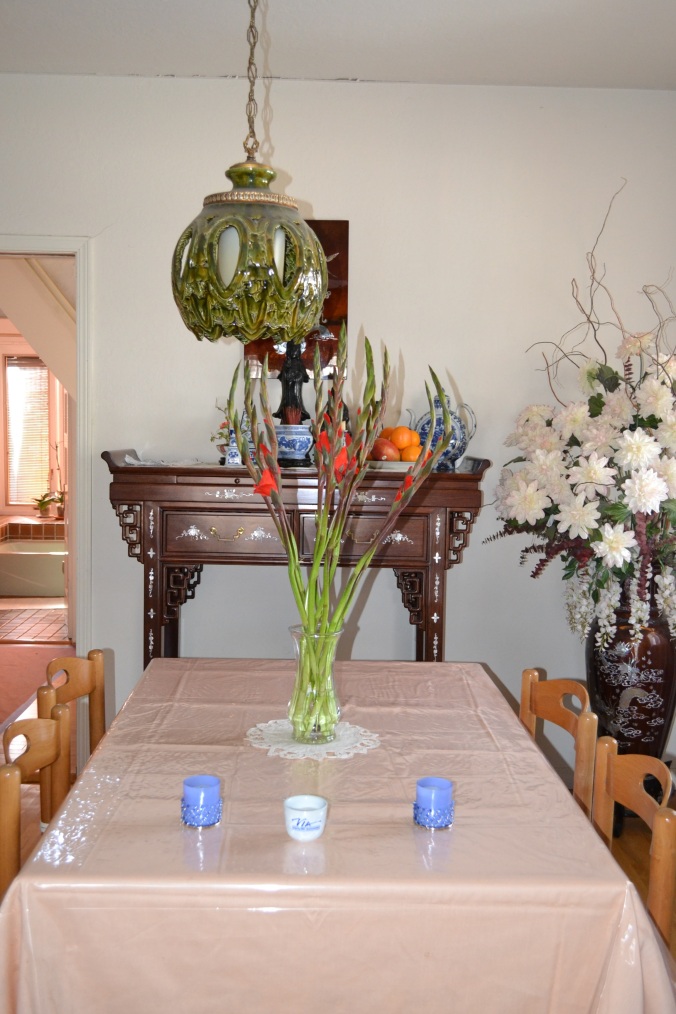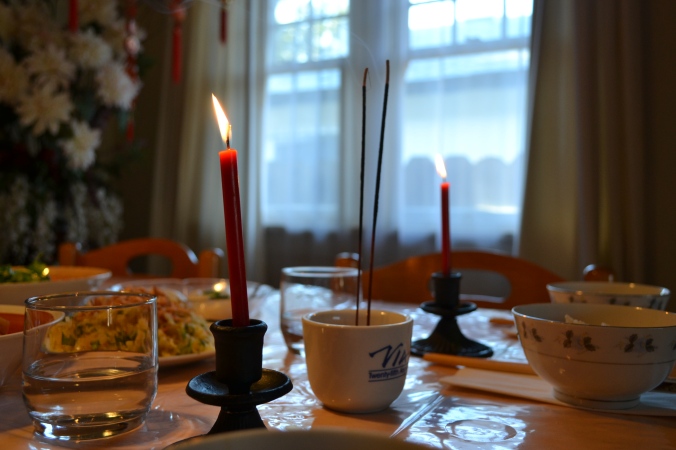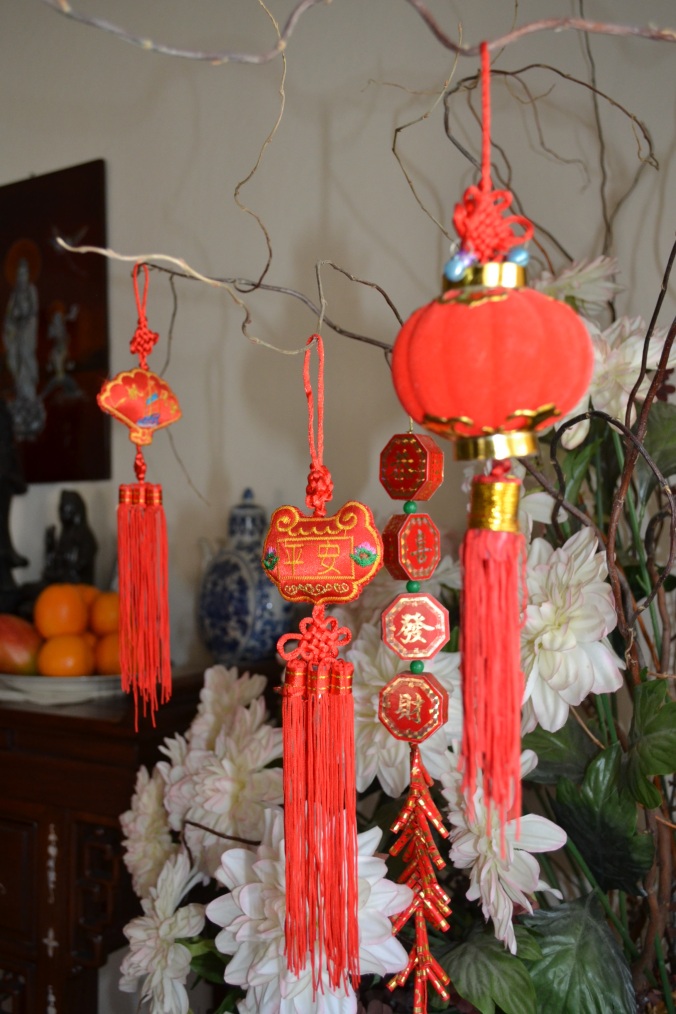02.08.2016
0800
So I just wanted to share the set up that my family uses for Tết. We use the alter, entryway dresser and dining table as our platforms. The alter is for Buddha (bàn thờ Phật), the entryway dresser is used for the Saint of the Property (Đức Đai) and the dining table is used for my ancestors (ông, bà).
Before the Tết ceremony begins: (Day 1)



During the Tết ceremony: (Day 1)






On the alter sits a bowl of dry rice in which we have placed many incense sticks (cây nhang) over the years during each Tết celebration. On the entryway table is the set up for the Saint of the Property (Đức Đai), which includes a small bowl of dry rice for the incense sticks, water glasses, a variety of foods such as soup (Canh), Vietnamese braised pork with eggs (thịt kho), Vegetarian stir fry egg noodles (mì xào chay), shrimp salad (gỏi tôm), and fresh fruit. On the dining table, there is a small bowl of dry rice for the incense sticks, three bowls of rice for my ancestors (one for my dad’s side, one for my mom’s side and the third is for all other ancestors), water glasses, candles and the same variety of foods as on the entryway table but in addition, there are also Vietnamese mung bean dumplings (bánh ít trần).
Tradition goes that when ceremony starts, each person always prays and greets Buddha first with 3 bows (ba xá) and 3 prayers (ba lạy) at the alter, then we move over to the entryway table and ask the Saint of the Property, permission (xin phép) to invite our ancestors to come and celebrate Tết with us with 2 bows (hai xá) and 2 prayers (hai lạy). Then at the dining table, we invite our ancestors to come and celebrate with us with 2 bows (hai xá) and 2 prayers (hai lạy). After each request, we each place one incense (cây nhang) into the designated dry rice bowl. At the end of the first round of bows, each person will visit each table again to ask permission to leave the ceremony, but using the same amount of bows and prayers per table that was used in the first round. This second round of bows and prayers will release the person to go on with their day as they please.
After the Tết ceremony: (Day 1)



The bows, prayers and the placing of the incense sticks are repeated each morning for three days (ba ngày Tết), during the three day celebration. At the end of the three day celebration, there will be another feast that will be the same set up on each table and on the alter in which we bid farewell (tiễn đưa) to our ancestors.
In the late evening (close to midnight): (Day 1)



In the late evening, we celebrate the New Years Eve (Cúng giao thừa) by lighting the alter candles and welcoming the new year. This ceremony includes three separate steps by the owner of the home. The first prayer (lạy Phật) takes place at the alter to Buddha with 3 bows (ba xá) and 3 prayers (ba lạy). Then the owner will step outside on the front porch of the home and prays to Heaven and Earth (cúng trời đất) with 3 bows (ba xá) and 3 prayers (ba lạy). The owner will then come inside to the alter and will pray to the lord of Heaven and Earth (lạy trời đất) with 3 bows (ba xá) and 3 prayers (ba lạy). The owner of the home will then place three incense into the rice bowl at the alter after these last three bows are completed. This last set of bows will end the ceremony of welcoming the new year.
This is an overview of what the set up is for my family for this year. There are traditional baked goods missing from this set up such as Bánh chưng (Vietnamese rice cake which is made from glutinous rice, mung beans, pork and other ingredients) and Bánh tét (savoury but sometimes sweetened cake, made from mung bean or mung bean and pork filling), as well as tea in addition to the water glasses. Each family has their own variation of what foods they cook or how they set up their ceremonies, this is just my family’s set up for this year.
So, Chúc Mừng Năm Mới! (Happy New Year) I wish you all a healthy and happy new year with plenty of wealth and triumphs throughout the year 🙂



 Notes:
Notes:
Good job A good food in Tet’s Days at Vietnam, however, eating it in normal days is ok ! ^^
A good food in Tet’s Days at Vietnam, however, eating it in normal days is ok ! ^^
Year round is definitely okay with me too
Thanks! Just wish I had some Dua Cai Chua to go with this. =]
its so hard to find vietnamese recipes i understand and use online. more more more.
=] sure thing.
This reminds me of a Korean side dish called “Jang Joh Rim.” I wonder if they taste similar!
Yeah it seems a lot of Asians share a similar variation of this dish!
Huy, do i cover the pot with a lid? or leave it open?
You only need to cover it slightly at the start so the liquid can reduce. Towards the end you can probably remove the lid entirely–adjust as needed.
Really great recipe, the step by step pictures are really appreciated. Thank you for sharing, and keep them coming!
Similar to adobo in the philippines:) ill try this recipe..
A friend made this as a comfort meal for me once and I loved it!
Now I can try making it for my family. Wondering if this needs to be simmered covered with a lid or left open to boil? Thanks
Lid open mostly, to reduce. If the meat is still tough you can add water as needed and continue to boil uncovered until it reaches a sauce thickness you like.
This is way better than the Filipinos’ adobo.
looks similar to adobo but taste way different to adobo trust me this dish is heaps tastier
make sure you use good fish sauce, like the one pictured above.
I love the pictures and the steps are very similar to my notes from my mom’s cooking lesson to me. The only thing is I just cooked it today with the country style boneless ribs and I compared it to the pork belly meat. Somehow the rib meat was more tough. Is there a way to make it more tender? I cooked 2hrs as your recipe dictates.
Also, many people asked & I wonder also, do you cook your pot covered or uncovered?
I cook it uncovered so the liquid can reduce (evaporate) to an amount I like. If you see it reduces too much you can put the lid back on or add some water.
As for toughness of the meat, different cuts will vary in amount of connective tissue. Just cook it longer if its still too tough. At first I was afraid to overcook it, but giving it more time has always resulted in tender results. Just check it every 15 minutes or so.
Just tried your recipe. Turned out so awesome. Thanks!!!
Is that a typo? This doesn’t take 20 hours does it? If so, can we cook this in a crock pot?
By the way, I’ve had this dish many times at parties and IT IS TO DIE FOR! I love that the ingredients are simple and so are the directions. Is there a substitute for the coconut soda, if I’m not able to find it? Thanks!
I’m DYING, that’s hilarious!! Yeah I meant to say 2 hours–oops, that’s been updated and thanks!
The best thing you can use is fresh coconut juice, coco soda 2nd, then 3rd is cola or lemon-lime soda. Hope that helps.
Can you substitute chicken or beef? I do not eat Pork. I’m sure it won’t taste the same but thought I would ask
Have you or can you substitute chicken or beef. I have taken pork out of my diet.
Hey Trinity, I personally haven’t tried it but I bet it would be pretty good too. I’ve had this with tofu instead of meat and really enjoy that version too!
Super easy recipe to follow, and ended up delicious! I used pork shoulder only because the local grocery store didn’t have any pork belly left, and the end product was still absolutely delicious! The meat was so tender and flavorful without being too salty. Thanks for sharing this recipe!
Hey Amy glad to hear you liked it! Yeah you can really use any cut of pork you want and it still turns out pretty well